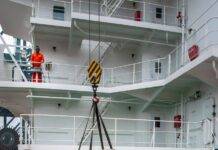
Web Sling Capacity Calculation: Ensuring Safe Lifting Operations
Web Sling Capacity Calculation : Web sling capacity calculation is a critical aspect of safe lifting operations. In industrial settings, the use of web slings is common for lifting heavy loads. However, it’s essential to understand how to calculate the capacity of web slings to ensure the safety of both workers and the loads being lifted.
Understanding Web Slings
Web slings are flexible, load-bearing straps made from materials like nylon, polyester, or polypropylene. They are versatile and used in a wide range of applications, from construction to manufacturing, and even in shipping and logistics.
The Importance of Safe Lifting Operations
Ensuring safe lifting operations is of paramount importance. Accidents caused by the overloading of web slings can result in injuries, damage to property, and significant financial losses. Proper web sling capacity calculation is the key to preventing such incidents.
Factors Affecting Web Sling Capacity
Several factors influence the capacity of a web sling:
Material Strength
The type and quality of materials used in the web sling greatly affect its lifting capacity. Stronger materials can handle heavier loads.
Sling Configuration
The way the web sling is configured and how it’s attached to the load and the lifting equipment impact its capacity.
Angle of Use
The angle at which the web sling is used can significantly reduce its capacity. It’s crucial to account for this in your calculations.
Load Weight
The weight of the load being lifted is a primary factor in determining the web sling’s capacity.
Types of Web Slings
There are various types of web slings available, each with its unique characteristics:
Nylon Web Slings
Nylon web slings are known for their strength and flexibility. They are suitable for various lifting applications.
Polyester Web Slings
Polyester web slings are durable and resistant to abrasion, making them an excellent choice for rough conditions.
Polypropylene Web Slings
Polypropylene web slings are lightweight and cost-effective, ideal for lighter loads.
Wire Rope Slings
Wire rope slings are exceptionally strong and often used in heavy-duty lifting operations.
Calculating Web Sling Capacity
Web Sling Capacity Formula
To calculate the capacity of a web sling, you can use the following formula:
Web Sling Capacity (WLL) = Material Strength x Sling Configuration Factor x Angle Factor x Load WeightWorking Load Limit (WLL)
The Working Load Limit (WLL) is the maximum load that a web sling can safely handle. It’s important to always stay below this limit to ensure safety.
Let's consider a real-life scenario to calculate the web sling capacity. Imagine you're working at a construction site where a team needs to lift a heavy steel beam using a web sling. Here's how you can calculate the web sling capacity in this situation:Scenario:
Task: Lifting a Heavy Steel Beam
Data:
- Material Strength of Web Sling: You are using a polyester web sling with a known material strength of 10,000 pounds.
- Sling Configuration: The web sling will be attached to the steel beam using a basket hitch configuration.
- Angle of Use: The web sling will be used at an angle of 60 degrees from the vertical.
- Load Weight: The steel beam weighs 5,000 pounds.
Calculation:
- Material Strength: As mentioned, the material strength of the polyester web sling is 10,000 pounds.
- Sling Configuration Factor: For a basket hitch configuration, the sling configuration factor is typically 2. In this case, it means that the capacity of the web sling is effectively doubled.
- Angle Factor: To calculate the angle factor, use the formula: Angle Factor = 1 / sin(θ), where θ is the angle of use in degrees. In our scenario, the angle of use is 60 degrees, so the angle factor is approximately 1.1547.
- Load Weight: The steel beam weighs 5,000 pounds.
Now, plug these values into the web sling capacity formula:
Web Sling Capacity (WLL)=Material Strength x Sling Configuration Factor x Angle Factor x Load Weight
WLL = 10,000 pounds x 2 (sling configuration factor) x 1.1547 (angle factor) x 5,000 pounds
Calculating this, you get:
WLL = 57,735.5 pounds
So, in this scenario, the Working Load Limit (WLL) of the polyester web sling when used to lift a 5,000-pound steel beam at a 60-degree angle in a basket hitch configuration is approximately 57,735.5 pounds.
It’s crucial to ensure that the load being lifted is well below this calculated WLL to maintain safety during the lifting operation. In this case, the 5,000-pound steel beam is within the safe working load limit of the web sling.
Safety Guidelines for Using Web Slings
To ensure safe lifting operations, follow these guidelines:
Inspecting Web Slings
Regularly inspect web slings for signs of wear, damage, or deterioration. Damaged slings should be taken out of service immediately.
Proper Storage
Store web slings in a clean and dry area away from direct sunlight and chemicals. This helps prolong their lifespan.
Correct Sling Usage
Always use the right type of web sling for the job and follow the manufacturer’s recommendations for usage.
Maintenance and Care
Proper maintenance and care of web slings are essential. This includes cleaning, lubrication (if applicable), and regular inspections.
Common Mistakes to Avoid
Avoid these common mistakes when using web slings:
- Overloading web slings.
- Neglecting inspections.
- Using damaged slings.
- Incorrectly attaching slings to loads.
Web Sling Capacity Standards and Regulations
Various standards and regulations, such as OSHA guidelines and ASME standards, govern the safe use of web slings. Familiarize yourself with these standards to ensure compliance.
Advantages of Proper Web Sling Capacity Calculation
By calculating web sling capacity correctly, you ensure the safety of workers and the protection of valuable assets. It also reduces the risk of accidents and costly damage.
Conclusion
In conclusion, web sling capacity calculation is a vital aspect of safe lifting operations. Understanding the factors that influence capacity, choosing the right type of web sling, and following safety guidelines are crucial. Accurate calculations can prevent accidents, protect workers, and preserve valuable equipment.
Web Belt Sling Working Load Limit (WLL)
Types of Crane in Construction
Crane Lifting Safety Toolbox Talk Meeting
FAQs
- What is web sling capacity? Web sling capacity is the maximum weight a web sling can safely lift without risking damage or failure.
- How often should I inspect my web slings? Regular inspections are necessary, and the frequency should follow manufacturer recommendations and industry standards.
- What are the most common materials used for web slings? Nylon, polyester, and polypropylene are common materials for web slings.
- Can I repair damaged web slings, or should I replace them? Damaged web slings should be replaced, as repairing them may compromise safety.
- Where can I find the relevant safety standards for web sling use? You can find safety standards and guidelines from organizations like OSHA and ASME, as well as manufacturer recommendations.






















Very helpful.